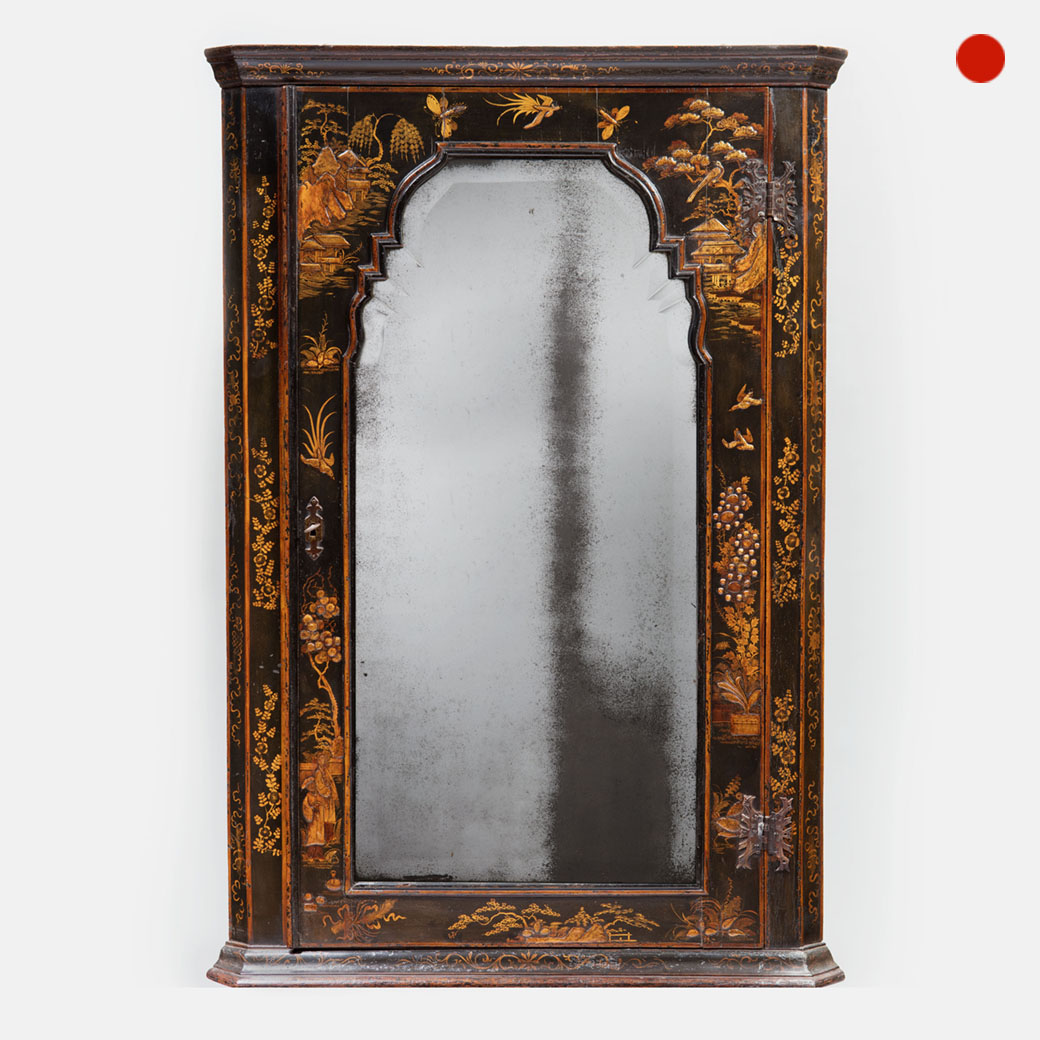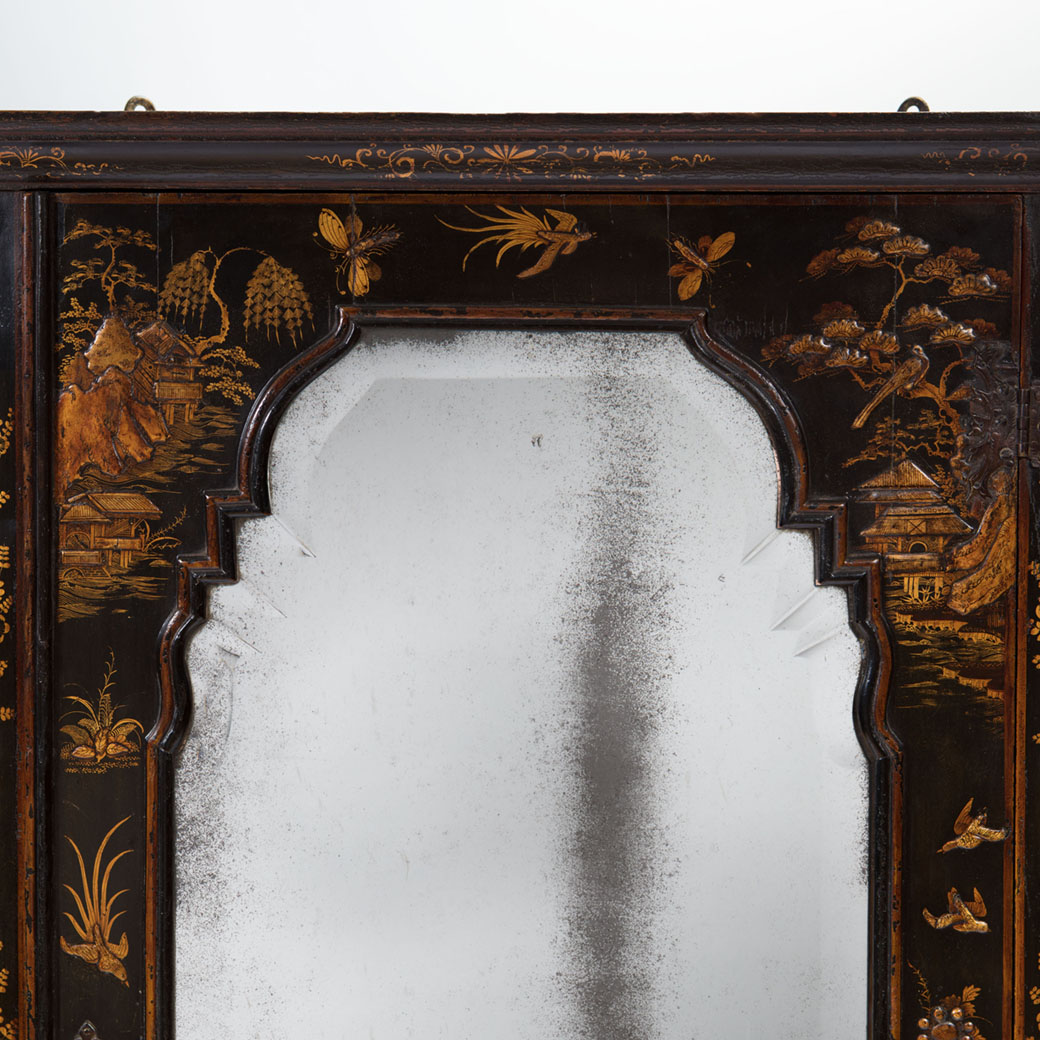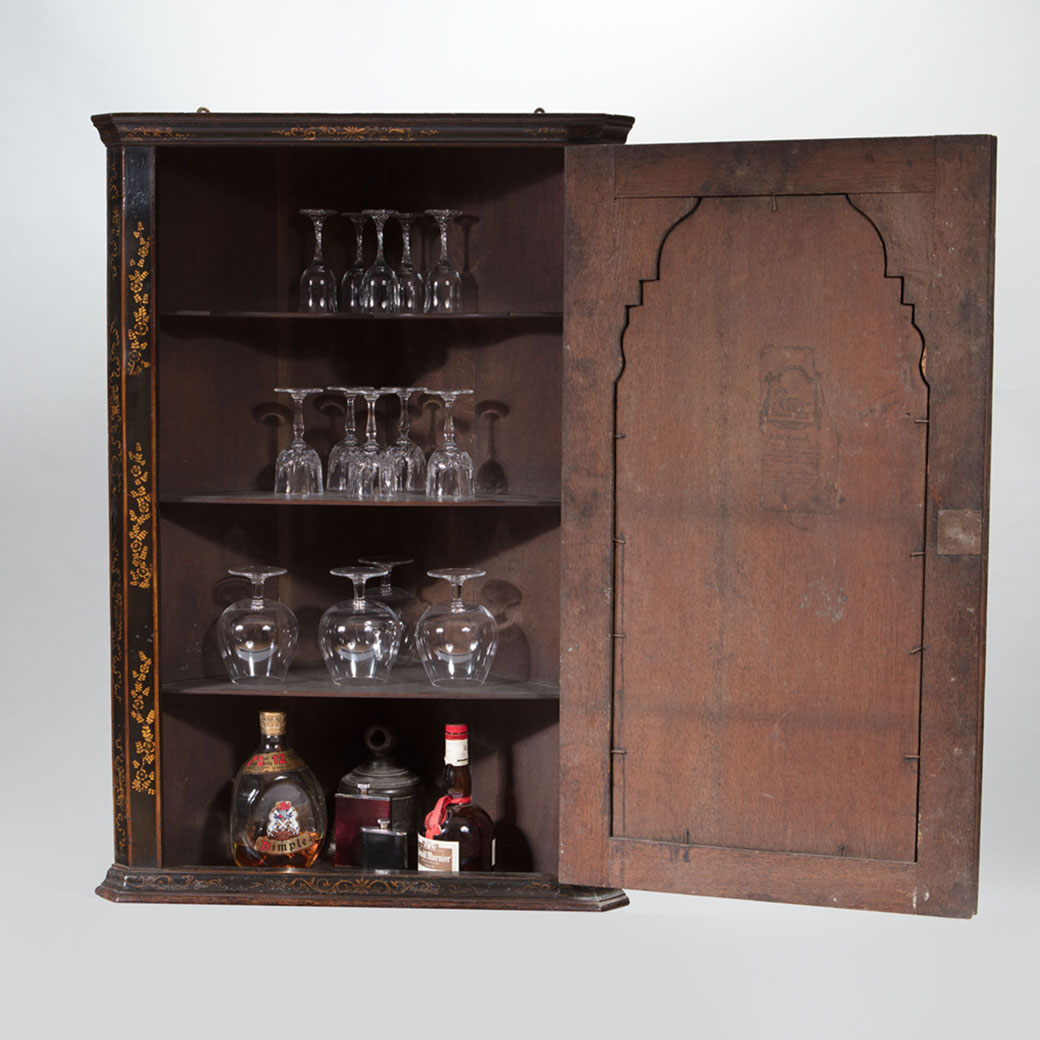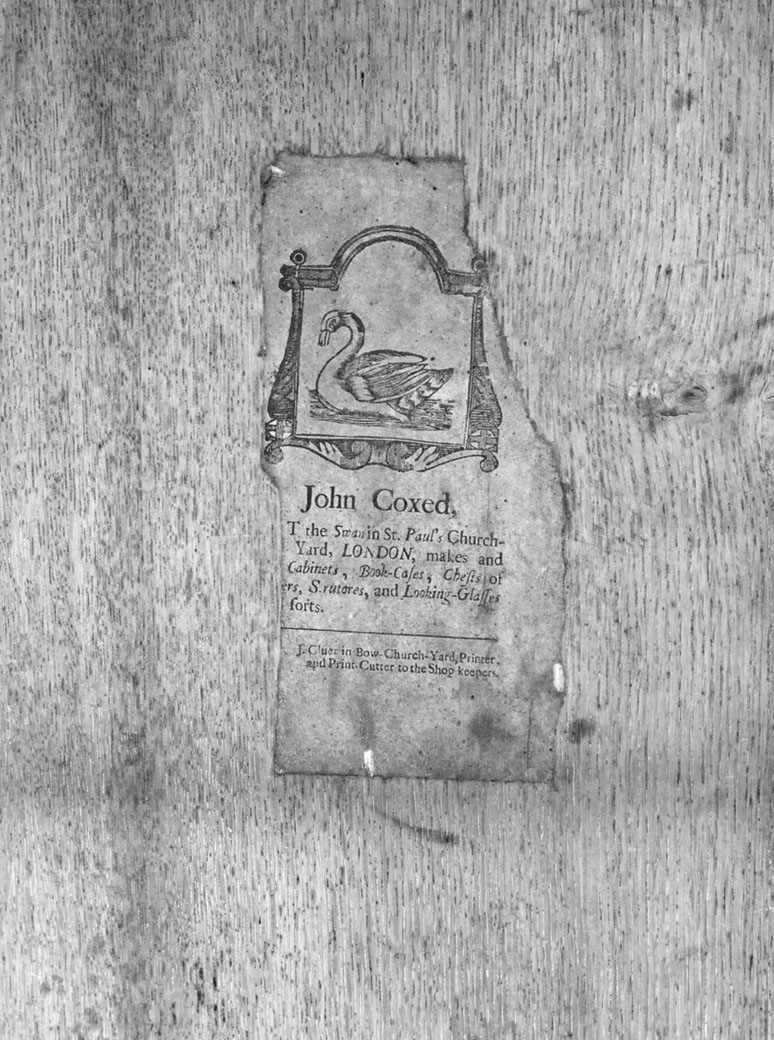JOHN COXED Also known as COXED & WOSTER (worked c.1700-c.1718)
Important Queen Anne Japanned Chinoiserie Corner Cupboard by John Coxed
1711-1715 England
Sold
Request Information
Follow Us
Important Queen Anne Japanned Chinoiserie Corner Cupboard by John Coxed
JOHN COXED Also known as COXED & WOSTER (worked c.1700-c.1718)
1711-1715 England
Important Queen Anne Japanned Chinoiserie Corner Cupboard by John Coxedard
The original bevelled mercury mirror plate is boarded by a double-d moulding and framed by its case of japanned, and detailed chinoiserie designs of differing forms. The chinoiserie work is incredibly fine for the period and includes figural scenes, a cliff face with lapping water, vegetation, insects, and birds to its entirety. The chased escutcheon is original along with the key, lock and opens to an interior of straight and shaped shelves of oak. Directly behind the mirror plate sits the original backboard with the earliest form of John Coxed trade label. The label reads “John Coxed T the Swan in St Pauls Church-Yard London, makes and cabinets, book-cases, chest of drawers, scrutoires, looking glasses, forts.” J. Clue in Bow Church-Yard Printer, and Print-Cutter to the shop keepers.
Six pieces of furniture bearing John Coxed’s labels have so far come to light, and they bear two different styles of label to which this is thought to be the earliest version. This corner cabinet is not only one, of the only now three known examples of the earliest form, but also the only recorded Japanned and chinoiserie piece by John Coxed (1711-1718). It is assumed that this label dates from 1711-1715 and the later version’ from 1715-18. This allows us the rare opportunity to accurately date this unique piece, to sometime between 1711-15.
Typically, Pieces by the outfit are veneered in walnut, mulberry or burr elm and stained to resemble tortoiseshell. Some pieces are embellished with kingwood cross-banding and pewter stringing. This metal line inlay was almost certainly due to the influence of Gerrit Jensen, who introduced such fashionable Continental habits into England in the late 17th century.
All known pieces by Coxed and Woster are in important private collections and museums, to include, The V&A Museum, Colonial Williamsburg, Rousham House and Alexander George Fine Antiques Ltd.
John Belchier also operated from the Southside of St Pauls Churchyard, just a few doors down from Coxed in the first quarter of the 18th century. The earliest reference to John Belchier can be found in the accounts of Boughton House between 1687 and 1710. Belchier is most famous for his Chinoiserie work and it is possibly or even highly likely that it was he who undertook the chinoiserie work of the corner cabinet we are offering.
Condition
Original condition
Dimensions
Height 38.00 inch (96.52 cm)
Width 26.00 inch (66.04 cm)
Depth 14.50 inch (36.83 cm)
Provenance
Private London collection
Literature
The trade label from this corner cupboard is illustrated in the ‘Pictorial Dictionary Of Marked London Furniture, 1700- 1840’, page 153, fig 236, by leading furniture historian Christopher Gilbert.
Dictionary Of English Furniture Makers 1660-1840, by The Furniture History Society, page 205.
PREVIOUSLY SOLD
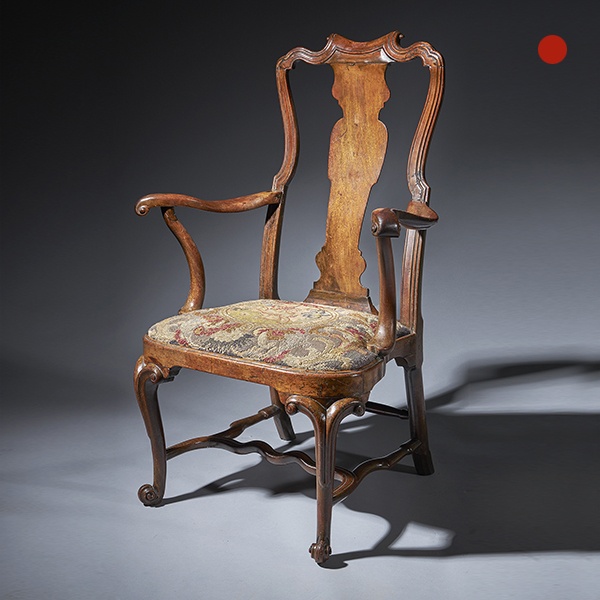
An extraordinary George I walnut armchair Circa 1725, England
An extraordinary George I walnut armchair of fabulous colour, form and patination. The chair is of the most lively shapes being either carved or turned.

A fine burr walnut George I dressing mirror. Circa 1715-25 England.
A fine burr walnut George I dressing mirror Circa 1715-25 England. SoldFollow UsA fine burr walnut George I antique dressing mirror An extremely rare and fine George I burr walnut dressing mirror raised on ball and bracket feet. The drawer...
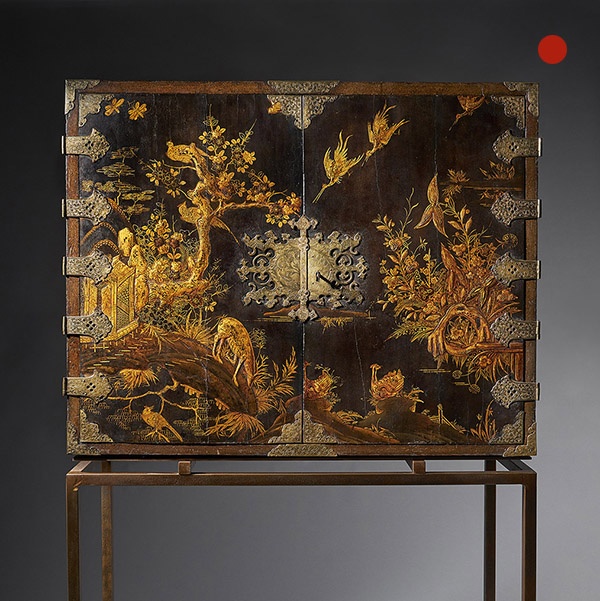
Charles II Japanned Cabinet of exceptional condition c. 1675 raised on a contemporary stand.
Charles II Japanned Cabinet of exceptional condition c. 1675 raised on a contemporary stand SOLD Follow UsCharles II Japanned Cabinet of exceptional condition c. 1675 raised on a contemporary stand An English Charles II Japanned cabinet of...
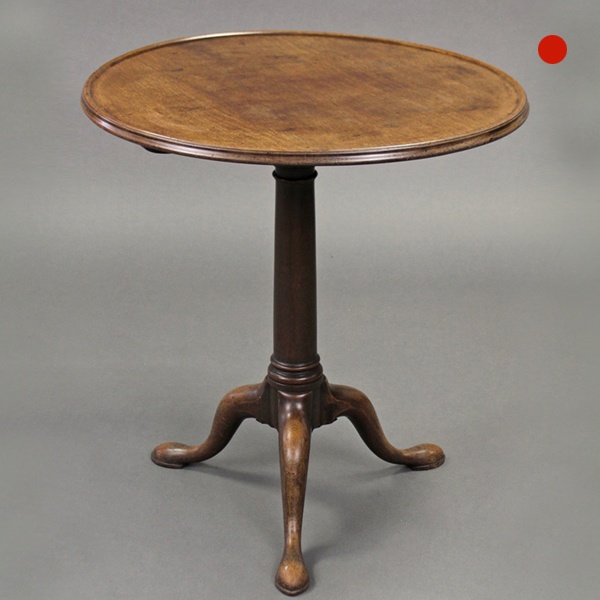
George III Mahogany Gun Barrel Tray Top Tripod Table Sofa Table Chippendale Period
A George III Mahogany Gun Barrel Tray Top Tripod Table, Sofa Table, Chippendale Period, circa 1770-1790, England. The circular tray top with moulded edge is raised on a gun-barrel centre column and cabriole legs with shaped pad feet.

George III Chippendale Period Mahogany Pie Crust Tray
A fine George III Chippendale period mahogany pie crust tray, circa 1770, England. Of circular form, with a carved and shaped edge. Alexander George Fine Antique sell 18th & 19th century antique English furniture.
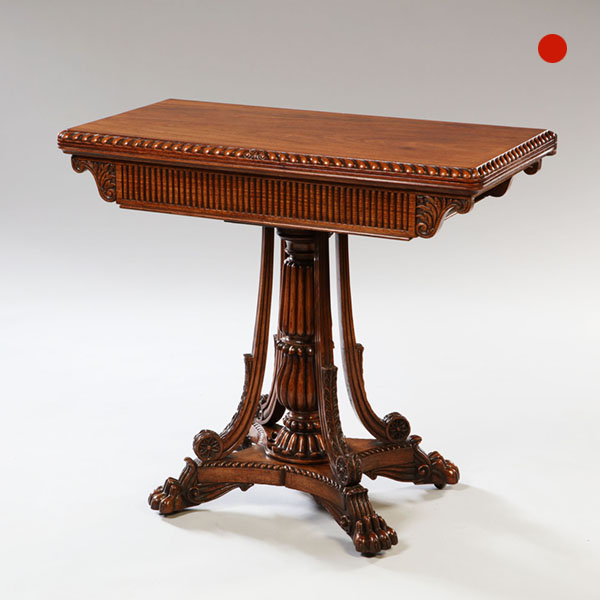
Solid Padauk Carved Anglo-Indian Card Table
Solid Padauk Carved Anglo-Indian Card Table. With the growth of trade and military power, the East India Company encouraged its British male employees to create a community with mixed ancestry. The company paid 15 silver rupees to the mother of any child born of such marriages.

An extraordinary George I walnut armchair Circa 1725, England
An extraordinary George I walnut armchair of fabulous colour, form and patination. The chair is of the most lively shapes being either carved or turned.

A fine burr walnut George I dressing mirror. Circa 1715-25 England.
A fine burr walnut George I dressing mirror Circa 1715-25 England. SoldFollow UsA fine burr walnut George I antique dressing mirror An extremely rare and fine George I burr walnut dressing mirror raised on ball and bracket feet. The drawer...

Charles II Japanned Cabinet of exceptional condition c. 1675 raised on a contemporary stand.
Charles II Japanned Cabinet of exceptional condition c. 1675 raised on a contemporary stand SOLD Follow UsCharles II Japanned Cabinet of exceptional condition c. 1675 raised on a contemporary stand An English Charles II Japanned cabinet of...

George III Mahogany Gun Barrel Tray Top Tripod Table Sofa Table Chippendale Period
A George III Mahogany Gun Barrel Tray Top Tripod Table, Sofa Table, Chippendale Period, circa 1770-1790, England. The circular tray top with moulded edge is raised on a gun-barrel centre column and cabriole legs with shaped pad feet.

George III Chippendale Period Mahogany Pie Crust Tray
A fine George III Chippendale period mahogany pie crust tray, circa 1770, England. Of circular form, with a carved and shaped edge. Alexander George Fine Antique sell 18th & 19th century antique English furniture.

Solid Padauk Carved Anglo-Indian Card Table
Solid Padauk Carved Anglo-Indian Card Table. With the growth of trade and military power, the East India Company encouraged its British male employees to create a community with mixed ancestry. The company paid 15 silver rupees to the mother of any child born of such marriages.
YOU MAY ALSO LIKE
No Results Found
The page you requested could not be found. Try refining your search, or use the navigation above to locate the post.
No Results Found
The page you requested could not be found. Try refining your search, or use the navigation above to locate the post.



